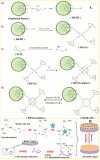Application Prospect of Ion-Imprinted Polymers in Harmless Treatment of Heavy Metal Wastewater
- PMID: 38999112
- PMCID: PMC11243660
- DOI: 10.3390/molecules29133160
Application Prospect of Ion-Imprinted Polymers in Harmless Treatment of Heavy Metal Wastewater
Abstract
With the rapid development of industry, the discharge of heavy metal-containing wastewater poses a significant threat to aquatic and terrestrial environments as well as human health. This paper provides a brief introduction to the basic principles of ion-imprinted polymer preparation and focuses on the interaction between template ions and functional monomers. We summarized the current research status on typical heavy metal ions, such as Cu(II), Ni(II), Cd(II), Hg(II), Pb(II), and Cr(VI), as well as metalloid metal ions of the As and Sb classes. Furthermore, it discusses recent advances in multi-ion-imprinted polymers. Finally, the paper addresses the challenges faced by ion-imprinted technology and explores its prospects for application.
Keywords: adsorption; heavy metal ions; ion-imprint; pollutants.
Conflict of interest statement
The authors declare no conflict of interest.
Figures










Similar articles
-
Preparation of nanocellulose grafted molecularly imprinted polymer for selective adsorption Pb(II) and Hg(II).Chemosphere. 2023 Mar;316:137832. doi: 10.1016/j.chemosphere.2023.137832. Epub 2023 Jan 11. Chemosphere. 2023. PMID: 36640989
-
[Magnetic ion imprinting techniques for the separation and analysis of elemental speciation].Se Pu. 2022 Nov;40(11):979-987. doi: 10.3724/SP.J.1123.2022.07013. Se Pu. 2022. PMID: 36351806 Free PMC article. Review. Chinese.
-
Construction of hyperbranched imprinted nanomaterials for selective adsorption of cadmium (II).Turk J Chem. 2024 Feb 20;48(2):364-375. doi: 10.55730/1300-0527.3664. eCollection 2024. Turk J Chem. 2024. PMID: 39050493 Free PMC article.
-
New ion-imprinted polymer for selective removal of Cu2+ ion in aqueous solution using extracted Aloe vera leaves as a monomer.Int J Biol Macromol. 2023 Jun 1;239:124318. doi: 10.1016/j.ijbiomac.2023.124318. Epub 2023 Apr 2. Int J Biol Macromol. 2023. PMID: 37015282
-
Molecularly Imprinted Polymers for Removal of Metal Ions: An Alternative Treatment Method.Biomimetics (Basel). 2018 Nov 30;3(4):38. doi: 10.3390/biomimetics3040038. Biomimetics (Basel). 2018. PMID: 31105259 Free PMC article. Review.
Cited by
-
The Multi-Challenges of the Multi-Ion-Imprinted Polymer Synthesis.Polymers (Basel). 2024 Oct 3;16(19):2804. doi: 10.3390/polym16192804. Polymers (Basel). 2024. PMID: 39408513 Free PMC article. Review.
References
-
- Xiang R., Zhou C., Liu Y., Qin T., Li D., Dong X., Muddassir M., Zhong A. A new type Co(II)-based photocatalyst for the nitrofurantoin antibiotic degradation. J. Mol. Struct. 2024;1312:138501. doi: 10.1016/j.molstruc.2024.138501. - DOI
-
- Wu Y., He X., Wang X., Xv J., Muddassir M., Istikhar A., Zhong A. Synergistic efficacy unleashed: Co/Ni-based catalysts as a versatile powerhouse for photocatalytic degradation of ornidazole. Inorganica Chim. Acta. 2024;568:122115. doi: 10.1016/j.ica.2024.122115. - DOI
-
- Zhang S., Li B., Wang X., Zhao G., Hu B., Lu Z., Wen T., Chen J., Wang X. Recent developments of two-dimensional graphene-based composites in visible-light photocatalysis for eliminating persistent organic pollutants from wastewater. Chem. Eng. J. 2020;390:124642. doi: 10.1016/j.cej.2020.124642. - DOI
Publication types
LinkOut - more resources
Full Text Sources
Research Materials

